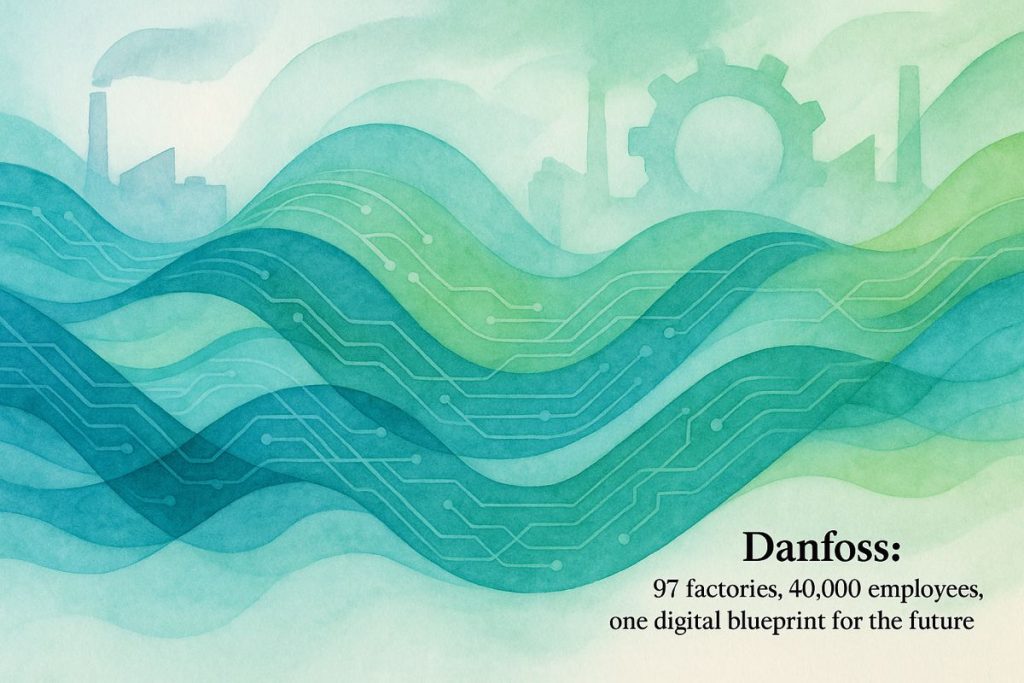Danfoss transformed its factories worldwide by uniting them under one digital system, using Siemens’ MES software and smart IoT sensors for real-time data and predictive maintenance. This shift let them make custom products faster, with fewer machine breakdowns and lots more efficiency. They trained their workers in new digital skills, making sure everyone could keep up with the changes. Now, Danfoss’ machines can “talk,” warning about problems before they happen, so work runs smoother and customers are happier.
How did Danfoss achieve digital transformation in its manufacturing operations?
Danfoss achieved digital transformation by standardizing platforms across global factories, implementing Siemens’ Manufacturing Execution System (MES) for real-time data and process templates, integrating IIoT sensors for predictive maintenance, and investing in comprehensive employee training. This approach enabled mass customization, improved efficiency, and reduced unplanned downtime.
Standardization: Herding the Digital Cats
Danfoss, that venerable Scandinavian stalwart with 97 production sites, more than 100 countries on its Christmas card list, and roughly 40,000 badge-wielding humans, didn’t just slip quietly into the night of digital transformation. No, they rallied their global fleet into a single, humming chassis—like synchronizing a symphony where each violin thinks it’s a drum. Five years, a few thousand coffee cups, and one or two existential crises later, Danfoss has written a blueprint for manufacturers itching to modernize.
Why bother? Because patchwork legacy systems and local workarounds were piling up like autumn leaves in Copenhagen, threatening to trip up innovation. Danfoss knew, with the quiet certainty of a cat watching a fishbowl, that harmonizing platforms and processes was the only path forward. So, they set their sights on a sweeping initiative: standardize the digital backbone, but don’t mummify the individuality of each business unit. I remember—years ago, I once tried to make all my spreadsheets “one-size-fits-all.” Result: chaos, not clarity. Lesson learned.
Their long-haul approach—no “quick wins” here, just a five-year roadmap with enough patience to rival a chess grandmaster—meant each factory, from Shanghai to Detroit, could plug into the same digital nervous system. And for the curious, Danfoss spills the beans on this vision in its Digital Transformation Overview.
MES, Data, and the Hyperspectral Shop Floor
You can’t orchestrate a transformation without the right baton. Enter Siemens’ Manufacturing Execution System (MES)—the digital glue in this industrial palimpsest. Danfoss used MES not just to weed out cranky legacy software, but to install a real-time, template-driven system. Each production line—imagine shimmering conveyor belts shot through with data—became visible, adaptable, traceable. Even the hum of the machines felt different: more focused, less frantic.
The MES platform’s template approach—think of it as a digital sourdough starter—let teams roll out new processes and variants faster than you can say “mass customization.” I had to stop and ask myself: how often do manufacturers really get to slice months off process changeovers? Sometimes never. Here, they did. And yes, Siemens gets a salute; the Siemens Case Study breaks it down.
But Danfoss didn’t stop at software. They tucked hyperspectral IIoT sensors into their lines, so every motor, every valve, could whisper its secrets. The result? Predictive maintenance, automated quality checks, and the ability to churn out millions of one-off products—each tailored, each traceable. No more “one size fits none.”
A memory: I once toured a Danfoss plant. The air smelled faintly of solder and machine oil—a kind of olfactory overture to innovation. A screen blinked: “Product variant #1,204,123 ready.” Bam! That moment, I felt a jolt of awe. For more on their digital threads, see the aPriori Case Study.
Humans, Change, and the Occasional Oops
Software and sensors are only half the alchemy. The true transformation is always personal—a rolling tide of change that can drown or lift, depending on how you ride it. Danfoss knew it needed to upskill its people, not just its machines. Cue comprehensive training, process standardization, even the dreaded process documentation. (Ugh. But necessary.)
Was there skepticism? Of course. Somewhere, someone always grumbles, “We’ve done it this way since ’92.” I confess, I’d have been one of them—change is scary. But Danfoss tackled it head-on, folding digital skills into daily ops. They didn’t just digitize manufacturing; they wove the new mindset into adjacent realms like ERP and CRM, so the digital current ran from shop floor to C-suite. One minor uncertainty? At first, the extent of needed re-training was underestimated. They course-corrected, expanding their programs—and participation swelled.
Their journey is chronicled, with the slight whiff of hard-won wisdom, in Automation World.
IoT, Predictive Maintenance, and the Road Ahead
Danfoss’ Power Solutions segment, in particular, embraced a robust IoT roadmap, drawing on partnerships with Trackunit and Proemion. The result was a new lexicon for the fleet: remote diagnostics, telematics, and predictive maintenance that feels as inevitable as sunrise. The machines no longer just break—they whisper, “Service me tomorrow.”
Fleet managers now have dashboards that glisten with data, like a hyperspectral scan of their entire operation. Unplanned downtime? Down by a notable margin—though the precise number is still a closely-held card. Customers, naturally, are reaping the benefits: lower lifecycle costs, fewer headaches, and the quiet confidence that comes from seeing problems before they erupt.
